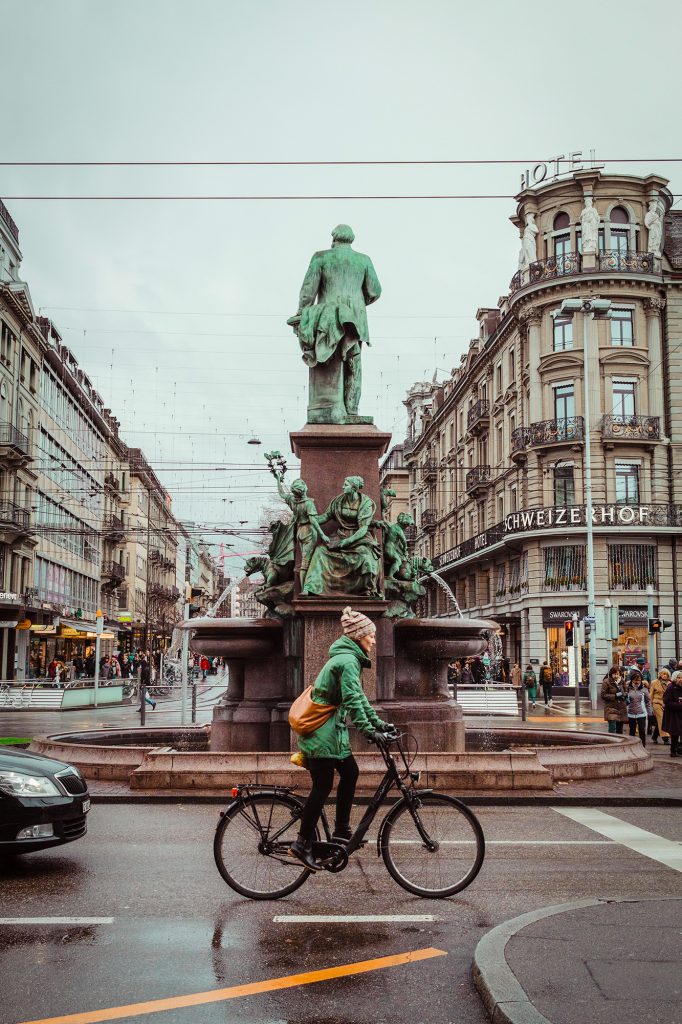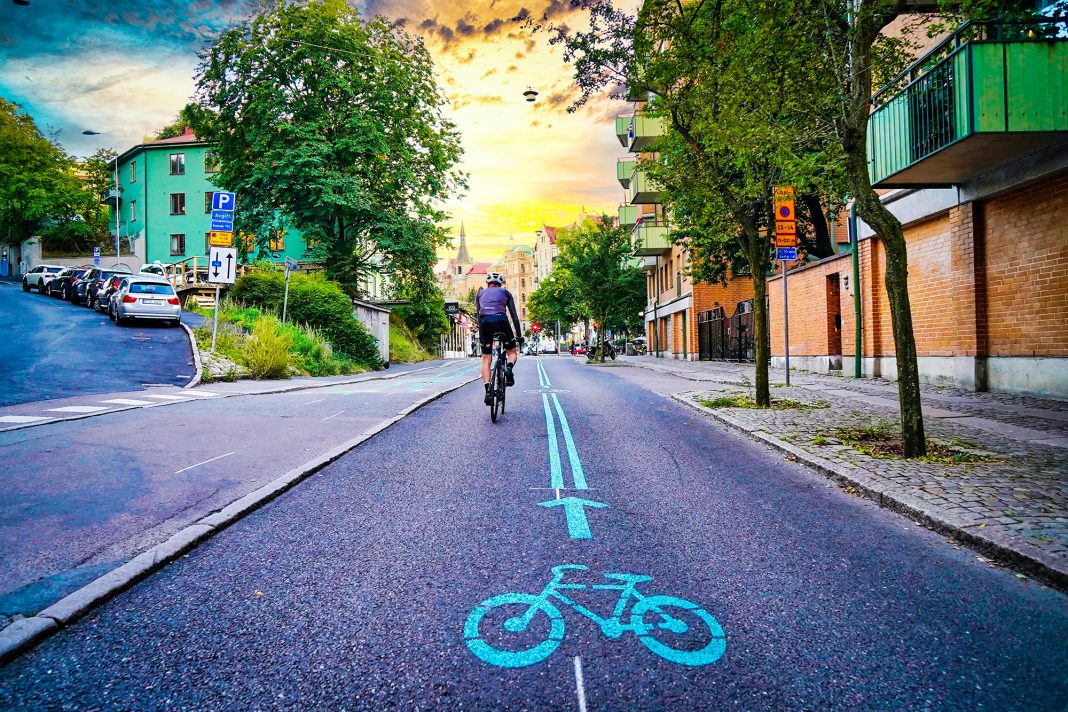Building a cycling network? Here’s everything you need – not just the pains and gains, but also the brains behind cycle lanes and the knacks behind cycle tracks.
No cycling city is complete without at least a few cycle routes. Colloquially, most refer to all forms of cycle routes as ‘cycle lanes’: there are, however, distinctions. Whilst cycle lanes consist of painted lines on roads, cycle tracks are separated from other traffic through some form of barrier.
The combination of cycle lanes or tracks, size and location differ across cities. We asked people working in the field what all the fuss over cycle routes is about, and how best to create them.
The Gains of Cycle Lanes

The two main gains of cycle lanes (and tracks) are the increased visibility and subjective safety of cycling.
Fear of traffic is one of the biggest obstacles to cycling. Certain demographics, particularly women, the elderly and children, will be reluctant to pedal around the city without the perceived protection of cycle routes.
“If you really want to increase cycling, you have to have segregation,” says Julian Baker, a cycling consultant at KontextPlan, Bern. This makes cycle tracks particularly important, as the physical barrier between traffic feels safer than a painted cycle lane. Cycle routes therefore quite literally lay the groundwork for people to come out and start cycling.
Lining a city’s streets with cycle routes also heightens the profile of cycling. Dedicated routes demonstrate a commitment to cycling and helps attract the attention of citizens. ‘Build and they will come’ is true to a certain extent with cycle infrastructure; once people see it and feel safer, it can unlock the city by bike.
The Pains of Cycle Lanes
“There is this problem I call ‘cycle path fetishism’ where we think that the solution to everything is a cycle path,” says Joris Van Damme, cycling expert at Provincie Vlaams-Brabant, Belgium.
If a city is too fixated on cycle paths, then it will neglect other options. Not every street will have the space to feature a cycle lane or track, which means that cyclists will be left unprotected when it ends. “Perhaps even more important than separate cycle lanes is just slowing down traffic, both the speed and volume which lead to this perception of lack of safety,” says Alex Baum, cycling advocate at BYCS, Amsterdam.
Moreover, some argue that cycle tracks are not necessarily objectively safe. “Bicycles are squeezed into a narrow lane whilst cars still have the street,” says Angela Azzolino, founder of Get Women Cycling, New York. She stresses that if there is an increase of users, such as cargo bikes, scooters and skateboards, or if bike lane maintenance is not prioritised, leading to potholes or piles of wet leaves, then navigating a small lane reduces safety long term.
Cycle routes can also be divisive. It involves redrawing the lines of space, which inevitably means overtly taking room away from something else. Opposition is therefore one of the main pains of cycle lanes.
The Brains Behind Cycle Lanes + The Knacks Behind Cycle Tracks
Knowing these difficulties, there are certain strategies that can make cycle routes a success. By following these, it should keep you on track and help you stick to the right path!
(a) Create a Hierarchy
Lucas Harms, Director of the Dutch Cycling Embassy, states that “the biggest thing we’ve learned in the Netherlands is that you need to have a network perspective.” This means planning cycling in a city comprehensively, by asking where it makes sense to mix cars with cycles and where they should be separated.
To do this, cities should create a hierarchy of routes. “For the main artery roads, where there is busy traffic, separate cycle and car infrastructure is essential,” states Lucas. Elsewhere, cycling can be mixed through traffic calming measures, such as reduced speeds, one-way systems and redirected car traffic to the hierarchy of busy roads. “In the Netherlands, almost 80% of all urban roads have been traffic calmed – so there is no need for separated bike infrastructure,” he says.
Intersections are particularly important to consider when creating a network, as crossings leave cyclists exposed to other traffic. Our article on intersections covers the key features.

“Having the same kind of infrastructure is crucial for networks,” says Isabell Eberlein, cycling consultant for Velokonzept, Berlin. “In Denmark they have four different types, so people always know what to expect.” A coordinated approach to cycling signage, colouring and routes will therefore make for a more cohesive network.
(b) Follow These Technicalities
Once you’ve planned the network, getting the details right comes next. If you read all the handbooks on cycle routes, they will tell you the following things.
The minimum space that a cyclists needs is a width of 0.9m and a headspace of 0.75m – this accounts for the size of the person and ‘zigzagging’ (where cyclists move from side to side to keep balance).
To allow for non-traditional bikes or two people to cycle next to each other, 1.9m should be the absolute minimum. Ideally, cities should be generous and allow for a more comfortable 2m.
Generally, the speeds at which traffic and cyclists should mix is up to 30km/hr, sometimes 40km/hr depending on the road width. Cycle lanes can be considered for roads with a speed of <50km/hr and a traffic volume of around 2000-3000 passenger cars units per day. Where roads have a speed of >50km/hr and the traffic volume is high, cycle tracks are the best option.
When planning a cycle network, avoid mixing pedestrians and cyclists because the average commuting speed of a cyclist is 18-29mph. Routes should be visible: print a cycling logo on the ground every 50 to 100m in built up areas, and every 500 to 750m in non-built up areas.
It goes without saying that cycle paths should be free of obstructions – cycling shouldn’t be a slalom race between wheelie bins, streetlamps, trees or post boxes. Where there are corners, these need to be curved to allow for cyclists to turn and surfaces should be smooth. Since the only cushion between the rider and the road is an exposed seat, try and keep it all even for the sake of saddle sore.
These are rough guidelines to help cities begin on their way; however, they can be tweaked as cities decided on their own path.
(c) Have a Political Strategy
Planning a network and deciding the technicalities will only get you so far down the road. The real challenge comes with gaining the political impetus to commence with the concrete.
Each city will have a distinct tactic or strategy. “Some cities want to do it perfectly, others immediately – there’s different levels of fine tuning,” says Mario Gualdi, project coordinator of CIVITAS Handshake. All that cities can do is learn from other’s tactics.

Seville’s strategy was to build permanent cycle tracks faster than opposing councillors could react. “In Spain there’s been a lot of planning about cycling, but then the plans get put into a drawer,” Seville’s Head of Urban Planning, José Garcia Cebrián, told the guardian. So it was a huge surprise when 80km of cycle tracks were built in 18 months, as no one thought it would actually happen – and by then it was too late to oppose.
The rapid building meant Seville compromised on some of the quality of cycle lanes, with the occasional tree or narrow squeeze. Bern, by contrast, pursued quality over pace. State of the art cycle tracks, with greenery and sensored traffic lights, have been lacing Bern’s streets. The strategy was to win support by showing how cycling would make the Swiss capital attractive. “The future belongs to cities with attractive public spaces and a high-quality bicycling and pedestrian infrastructure,” Ursula Wyss, the politician heading Bern’s ‘Velo Offensive’ told us.
Calgary’s approach was to build temporary bike tracks – unlike Bern’s or Sevile’s permanent routes. To win bike-sceptic councillors over, a pilot downtown network was launched. “The councillors who were resisting hoped that it would fail, and they would be able to kill it,” said Stewart Midwinter, co-founder of Bike Calgary. Fortunately, the pilot was a huge success, so much so that the council agreed to make it permanent in 2016.
Other cities have relied on a determined political figurehead to push cycling through. Bogota’s staggering record of 300km of protected bikeways built in 3 years can be attributed to the former mayor, Enrique Peñalosa. “I had a dream, I was obsessed with bicycles,” he told us. “I was too busy working to worry what people thought of me.”
Oulu similarly relied on a determined individual to become the world’s winter cycling capital. Despite the winters of up to -30C degrees, Oulu has a cycling modal share of 22%. This is largely thanks to a stubborn traffic engineer who sought to accompany roads with walking and cycling routes during the 1970s automation era.
No cycling city bares the same story of how they secured cycle routes. Any new city trying to build a cycle network can learn from other’s strategies – but ultimately it will have to write its own plot to its cycling story.
In a Nutshell…
Now you know the brains behind cycle lanes and the knacks behind cycle tracks, you can begin to work on your cycling network. Don’t become a ‘cycle-path fetish’ and know that your routes are more likely to be shaped by politics than landscapes. In the end, the pains outweigh the gains!


